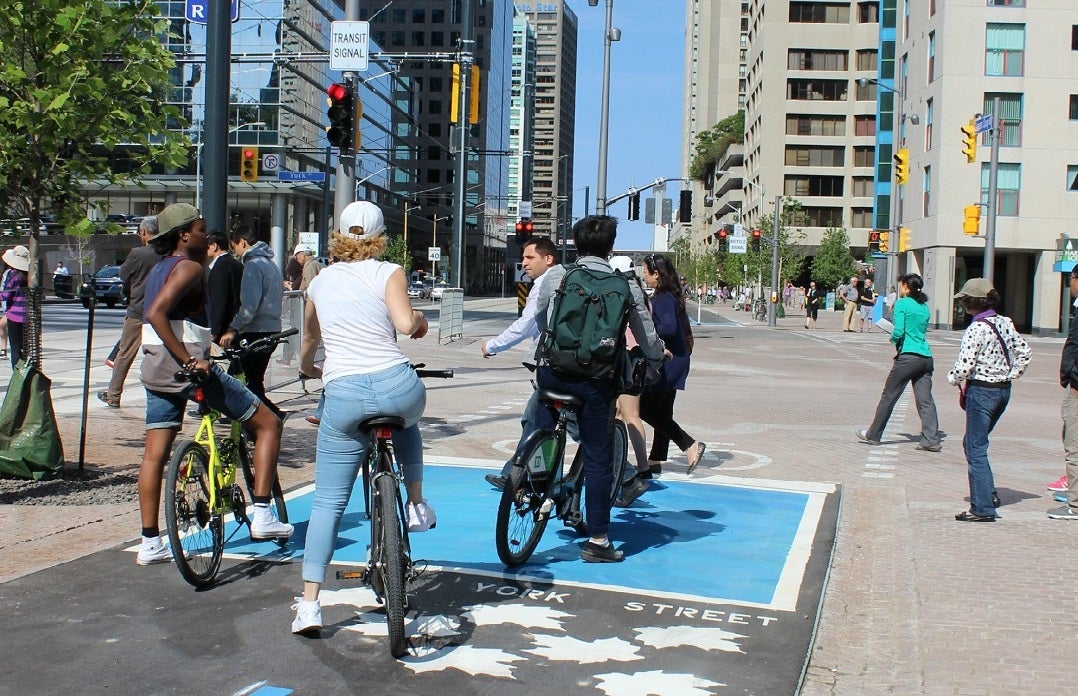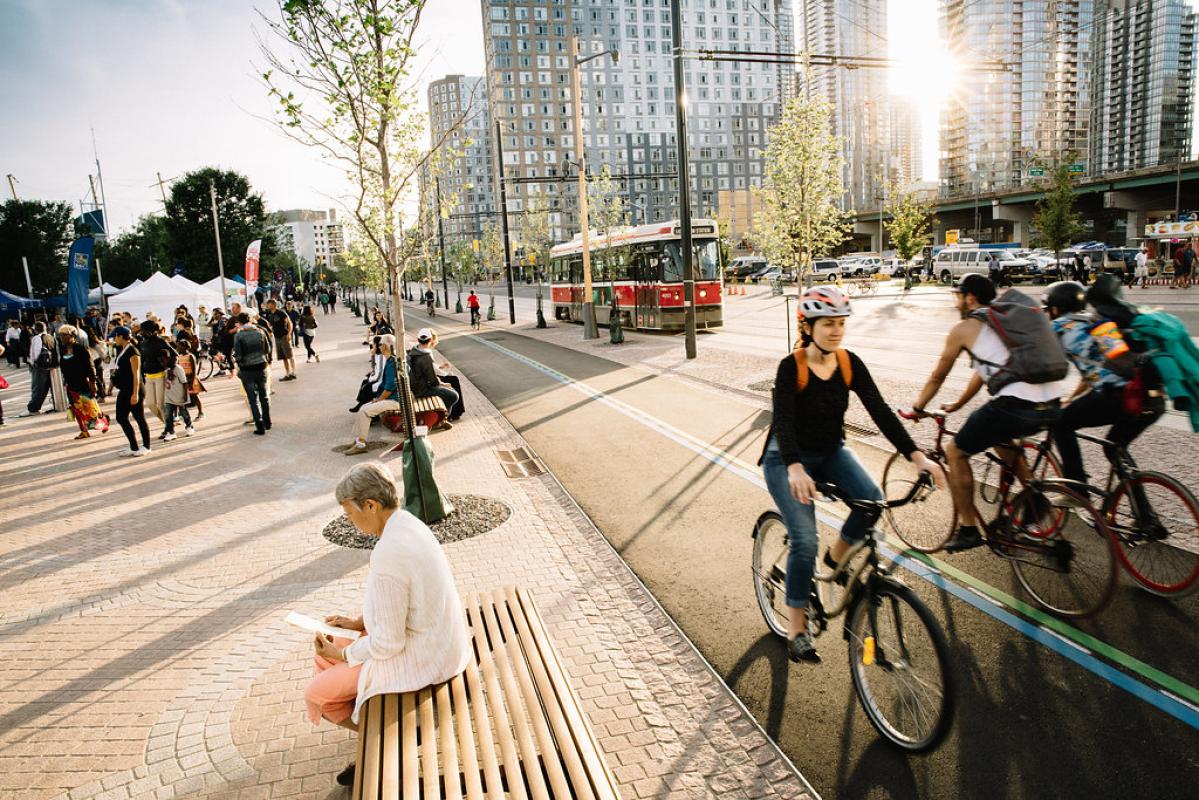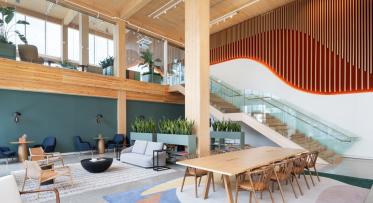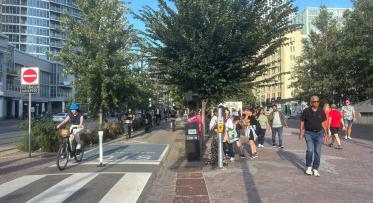We Want Your Feedback on the New Queens Quay
On June 19, we celebrated the opening of your new Queens Quay with the biggest ribbon cutting Toronto has ever seen. Now we’ve entered a period of commissioning and adjustment for the new street – and we’d like your feedback. (Photo: Connie Tsang)
POSTED: JUNE 25, 2015 I DESIGN, CYCLING, PARKS AND PUBLIC SPACES, TRANSPORTATION, COMPLETE STREETS
BY: MIRA SHENKER
The New Queens Quay was designed as a public space and transportation corridor that people can safely and comfortably. With that in mind, the traffic rules and corresponding signage, signals and line painting that Waterfront Toronto, the City of Toronto and TTC approved for this street were chosen based on typical driver, pedestrian and cyclist behaviours – that’s why they are all codified in the Ministry of Transportation’s guidelines.
Before construction began on Queens Quay, our design team built a model of the new “mixing zones,” and walked local residents through the mocked up intersections and driveways. We then adjusted the design based on their feedback. The raised curbs you see at the end of TTC platforms and humps in the vehicular ramps – a visual cue to help drivers avoid the pedestrian ramps – were just a few of the changes to evolve out of these sessions.

The blue bicycle boxes on the Martin Goodman Trail and white stop bar tell cyclists where to stop at their red lights in order to let pedestrians cross the “mixing zone” safely.
Now the street is open. There’s no need for a model – we’re able to observe people driving, walking, cycling and riding transit along the revitalized Queens Quay. We’ve received lots of positive feedback from people as they start to use the new pedestrian promenade, Martin Goodman Trail and east-west traffic lanes. We’ve also received plenty of constructive feedback from people noticing trouble with some of the street’s new features.
While we can’t stop pedestrians, cyclists and drivers from disobeying signs and signals, we’re looking at reinforcing this standard signage, signals and line painting in certain places to make sure the rules are even more clear than they are now.
We’ve already identified a few trends that we’ll address with new signage and line painting:
- We’re exploring ways to help drivers follow the dedicated turning signals at intersections, including additional signage (in addition to the “NEW” starburst signs we installed)
- We've recommended additional line painting to further delineate the streetcar right-of-way and guide eastbound cars into the correct spot (at all applicable intersections) – this is being reviewed by the City of Toronto and the TTC
- The TTC and City of Toronto have approved additional “Do Not Enter” signs to make it clear cars don’t belong on the streetcar right-of-way. Those signs have been ordered.
- We’ve heard from many of you that you’re concerned about the gap in the Martin Goodman Trail as you cross the Portland Slip at Queens Quay and Dan Leckie. The ultimate vision for this spot – a WaveDeck – is included in both our Central Waterfront precinct plan and the City of Toronto’s proposed Bathurst Quay Neighbourhood Plan but is currently unfunded. This will create the necessary space for a wide promenade separate from the Martin Goodman Trail. We explored the possibility of creating a temporary deck over the lake in this area, but because building any structure over the lake is complex, this was a prohibitively expensive solution. In the short-term, we’re working with the City of Toronto to determine how best to alert cyclists to the 60-metre gap in the trail (line painting or additional signs). We’re also assessing an interim solution that would create more space at this pinch point. Because this extension of the Martin Goodman Trail was only approved and tendered in January 2015, there was no time to implement any such solution before the Pan Am / Parapan Am Games. We felt it was more important to open the new Martin Goodman Trail from Bathurst to Stadium Road with a less-than-perfect solution in this short area than not to open it at all.
- We’ve recommended that the City approve standard trail signs to mark the Martin Goodman Trail along the south side of Queens Quay
- We’ve heard that people would like stop signs on the south side of Queens Quay for cyclists crossing at Stadium Road and Little Norway Crescent and are prioritizing that request
These are a few of the adjustments we’ve decided to make after consulting with our project partners. The current street design – including the line painting, paving material at intersections, and traffic configuration – is the result of strategic design as well as extensive consultation with stakeholders, the public, the City of Toronto and the TTC. Everything you see on the new street has been designed in accordance with Highway Traffic Act and approved by City of Toronto.
How changes will be made
Adjustments are common after any major infrastructure project opens – but changes can’t be made ad hoc. This was a thoughtfully designed street – decisions were based on extensive studies and consultation. Any proposed changes to the existing regulatory signage and signals must be carefully reviewed and considered in the context the extensive traffic studies that were already undertaken, permit drawings that the City approved, and our commitments to our stakeholders (for example, business owners along Queens Quay with whom we consulted extensively throughout this process). Proposed changes then have to be approved by the City of Toronto and the TTC before we can implement them. Any changes we make also have to comply with the Highway Traffic Act. We’ve arranged a task force of TTC and City of Toronto Transportation staff to conduct ongoing reviews based on what we’re observing and what we’re hearing from the public. In the meantime, we have installed temporary signage in some areas to help alleviate any confusion as people acclimate to the new street layout, and will install more as needed.
We want to hear from you
To supplement our observations, we’re also seeking feedback from the public. We’ll collect feedback over the summer and consolidate it with our own observations, helping us to identify trends and issues that need to be addressed. We’ll then review these findings with the project team, City of Toronto and TTC, agree on solutions and implement them.
We’ll release an official report outlining our findings and solutions – both planned and executed – in September 2015. At that time, we will also hold a more formal public consultation meeting.
How to submit your feedback
- Fill out this online form [LINK]
- Join us on a site walk. We’ll be holding bi-weekly public site walks this summer. No need to register – just drop in and meet with members of our project team on Queens Quay. The next walk is scheduled for July 13 at 5:30pm. We will depart from the Simcoe WaveDeck.
- Contact us at info@waterfrontoronto.ca
To learn more about some of the new design elements on Queens Quay – and for a list of FAQs about the new street – read our article entitled 'A Walk through the Revitalized Queens Quay' [LINK].




